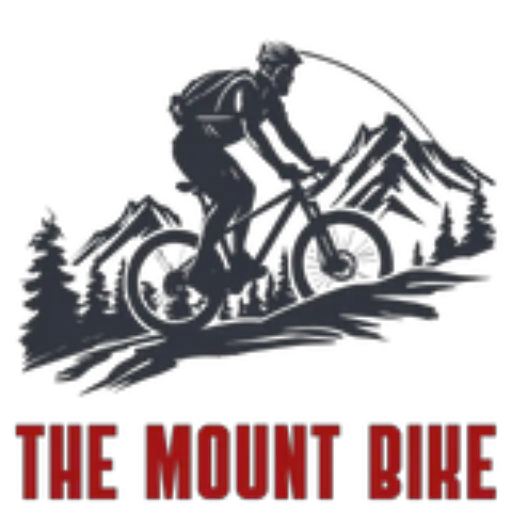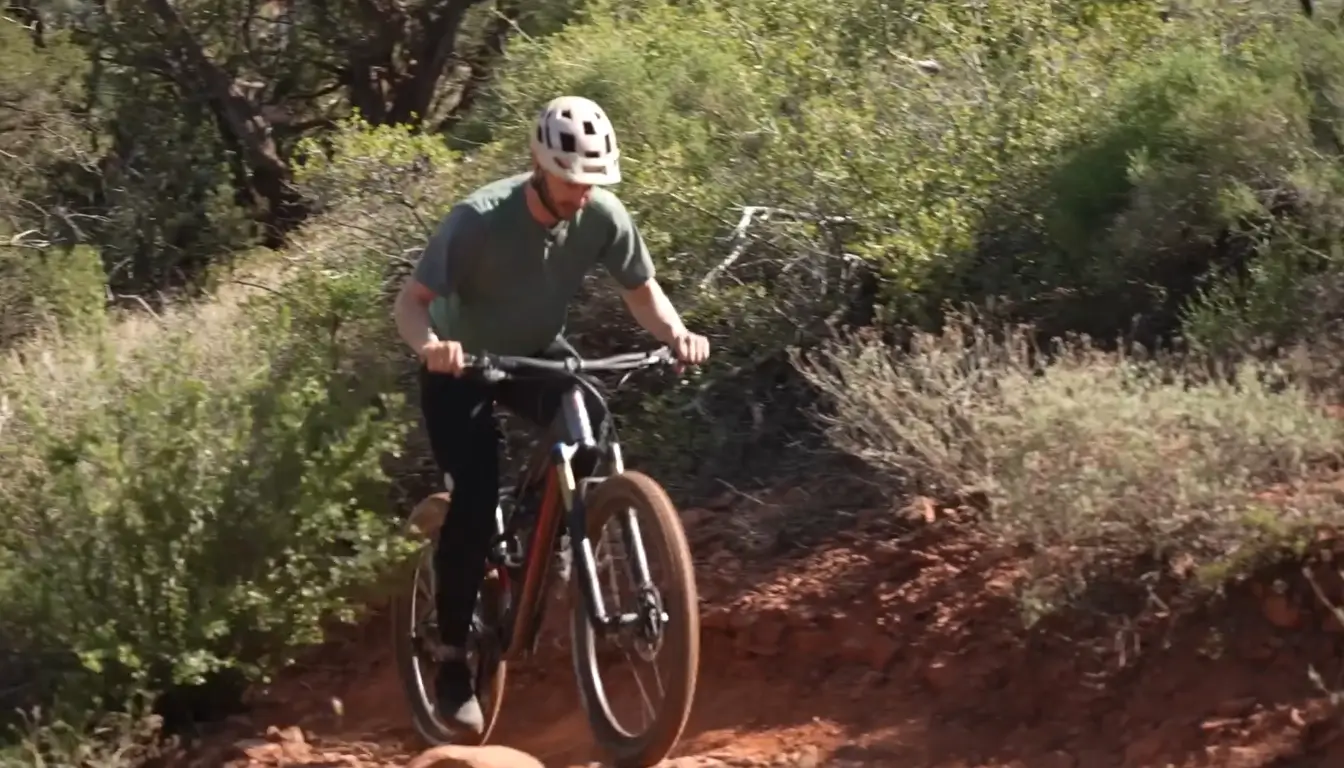You’ve ridden a few trails and know your way around the block. You can use bunny hop, rock hop, and maybe even drop in.
But to master mountain biking, you need to have some essential skills under your belt — skills that will allow you to tackle any trail confidently. I’ll share the essential skills to ride any basic mountain bike trail.
I’d like to show you how to get up into the air, do a few tricks, and have some fun, but how many skills do you need to take on board to get through this primary trail safely?
Let’s find out.
Essential Skills To Ride Any Mountain Bike Trail
I’ll share six basic skills to get through a primary trail: body positioning, braking, cornering, pumping, looking in the head, and linking the whole trail together. Hop on.
Body Positioning

You don’t know what to expect on the trail. That’s why you need to consider a few things, and one of them is saddle height. If you have a dropper post, get as low as possible, but if you don’t have a dropper post, undo that quick-release or bolt and bring that saddle and seat post down as low as possible.
As much as you can to get out of the way, but by doing that, you’re going to let your body weight venture over the back a little bit, especially when you get into a steep section; you can bring that body weight a little bit back.
- Run through all the wrongdoings of the body position; people are riding where their cranks are in a low position. That is a recipe for disaster because your foot is super low to the ground.
- It’s rougher than the road, so by doing that, you’re essentially going to hit rocks, and it’s going to ping you off the trail, and it’s going to cause a little bit of an accident.
- Another one is straight legs, straight arms all locked up, quite nervous-looking, you’re all a bit stiff, and you can’t move your body.
- Another correct way you want to do it’s to loosen up a little bit, get your elbows bent, and bend your knees. It’ll help if you pedal with the same level feet and central on the pedals.
Bend your legs, bend your elbows, and get into that press-up position. Raise your elbows relatively high up, but when you’re having this all bent, don’t get stiff and get stuck.
Look Ahead and Keep Your Heads High
You can’t be distracted while riding on a trail. If you’re distracted for a split second, no one knows what will happen next.
So, when riding on a rail, I’d strongly recommend looking ahead and keeping your head high. See what’s coming up, and focus on particular objects that will be in your way so you can make a decision before you get to it.
Braking

Break before you get into a turn. Slow you down a bit. Stand up a little bit, and it’ll slow you down. You’re going up, going out the berm, or into the rough stuff inside the turn.
Many people ride berm and turn way over the corner; the inside foot is down low, and the outside foot is relatively high.
- What you can do in a berm is have your feet level depending on what foot you have forward. As long as your cranks and level your body weight are set back, your hips are pushed up to the top of the berm you’re looking forward to.
- You concentrate on the exit you are rolling through without slapping those brakes, but this differs on a different turn.
- The pedal level is critical when you’re going into a turn because your body weights quite centrally on a bike, as I’ve explained, but another thing is don’t be scared of the berm.
- Know the speed you’re going, you’ll stick into that turn, and you’re looking ahead because if you kind of venture off into the bottom of the berm, it’s going to be a little bit slippery and greasy with stones and all that dirt.
Techniques can change when riding flat turns because there’s no bank for you to ride and catch a grip. You should drop that outside foot and move your body weight to the back wheel so the wheel can dig in and get a maximum grip.
Pumping
Pumping in the trail is never flat. A mountain bike trail will be rough, lumpy, and jumpy. Here’s how you can pump in the right way.
- When encountering a speed bump, you’re in that attack position and the correct body position. What you want to do when you ride it up is you want to let the bike rise up into your body. Let it come up into you, bending your knees and elbows.
- Then when you come to the other side where you want your bike to roll down, you are pushing down on the bike, letting it drop away from you.
- You can keep the bike relatively low and central and leave it on the ground. But it’s the same technique for a roller or a dip in the ground.
- A little dip in the trail is the same as going over a little lump. But what you want to do is let your bike push, so you squash the bike into the ground, letting it drift away from you.
- Then when you gain through the whole transition coming out the other side, you want to essentially do what you do on a speed bump to let that bike come up into you again.
Linking the Whole Trail Together
A trail is never flat, never straight, and it’s also never easy because it’s got lumps, bumps, turns, corners, and everything, like I’ve said.
But bringing all those skills that are spoken about into one practice by linking up the trail ahead of you will help you conquer that trail.
It’s all about nailing those skills together, so it’s all about having the correct body position, looking in the head, having the correct braking technique in your corners, being confident in the corners, and it’s all about linking up the whole thing by pumping through the trail getting you to flow on and keep conquering.
Cornering
Cornering on a mountain bike is all about being confident, looking straight ahead, and then trusting the corner and your body position. This is when it’s important not to dive from side to side as you round the corner. Get into that Attack Position, bend your knees, bend your elbows, and go with it.
You can ride it flat and get a full maximum grip. But don’t drop your inside foot. That pail is going to be scraping the ground. You’re not going to get your full lean on, you’re not going to get a maximum grip, and it could ping you, and off the trail, you could hit that tree.
Video: Improve Your Cornering
FAQs
- What skills do you need to ride on a mountain bike trail?
Only a few basic skills can help you conquer the trail, including body positioning, braking, observing the road ahead, pumping, and cornering. That will do it.
- What are the three steps to riding a bike?
The three steps to riding a bike are balancing, braking, and pedaling. Maintaining these three will give you a smooth riding experience and success.
- Why is mountain biking so hard?
What makes mountain biking so hard is the trail or the road. Bumpy, narrow roads, tight corners, and frequent speed bumps make mountain biking tough. But nothing is impossible. With proper practice, you’ll get there.
Final Word
This guide should give you a better understanding of what you must do when riding a mountain bike trail. It’s all about learning new mountain bike skills and securing yourself with the correct body position.
The main reason why many people fail is that they think that riding a mountain bike trail is easy. But no matter how much you think it’s easy, it’s not. Before you can ride a mountain bike trail well, you have to know how to ride at all.
Happy riding!

I am Ryan Ford, a mountain biking enthusiast who loves to explore the outdoors. I also like to go on adventures with friends and anything else that involves being outside. I love my bike because it gets me out of the house and gives me an opportunity to enjoy nature.

